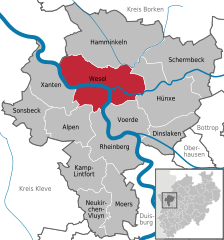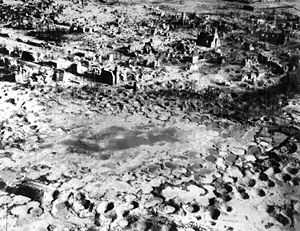Wesel
| Wesel | ||
|---|---|---|
|
Willibrordi-Dom in Wesel | ||
| ||
 Wesel | ||
Location of Wesel within Wesel district 
 | ||
| Coordinates: 51°39′31″N 6°37′4″E / 51.65861°N 6.61778°ECoordinates: 51°39′31″N 6°37′4″E / 51.65861°N 6.61778°E | ||
| Country | Germany | |
| State | North Rhine-Westphalia | |
| Admin. region | Düsseldorf | |
| District | Wesel | |
| Government | ||
| • Mayor | Ulrike Westkamp (SPD) | |
| Area | ||
| • Total | 122.617 km2 (47.343 sq mi) | |
| Population (2013-12-31)[1] | ||
| • Total | 60,070 | |
| • Density | 490/km2 (1,300/sq mi) | |
| Time zone | CET/CEST (UTC+1/+2) | |
| Postal codes | 46483, 46485, 46487 | |
| Dialling codes |
02 81 0 28 03 (Büderich) 0 28 59 (Bislich) | |
| Vehicle registration | WES | |
| Website | www.wesel.de | |

Wesel (German pronunciation: [ˈveːzəl]) is a city in North Rhine-Westphalia, Germany. It is the capital of the Wesel district.
Geography
Wesel is situated at the confluence of the Lippe River and the Rhine.
Division of the town
Suburbs of Wesel include Lackhausen, Obrighoven, Ginderich, Feldmark,Fusternberg, Büderich, Flüren and Blumenkamp.
History
Origin
The city originated from a Franconian manor that was first recorded in the 8th century. In the 12th century, the Duke of Clèves took possession of Wesel. The city became a member of the Hanseatic League during the 15th century. Within the Duchy of Cleves, Wesel was second only to Cologne in the lower Rhine region as an entrepôt. It was an important commercial centre: a clearing station for the transshipment and trading of goods.
Early modern
In 1590 the Spanish captured Wesel after a four-year siege. The city changed hands between the Dutch and Spanish several times during the Eighty Years War. In 1672 a French force under Louis II de Bourbon, Prince de Condé captured the city. Wesel was inherited by the Hohenzollerns of the Margraviate of Brandenburg in 1609 but they were unable to take control of Wesel until the Treaty of Nijmegen in 1678. Although the city had been heavily fortified the Prussians evacuated the city during the Seven Years' War and it was occupied by the French. It was returned to Prussia at the end of the war. Friedrich Wilhelm von Dossow was the Prussian Governor of Wesel during the 18th century. Wesel was ceded to the French in 1805 under the treaty of Schönbrunn. The French heavily fortified the city constructing a rectangular fort called the Citadelle Napoleon at Büderich and the Citadelle Bonaparte on an island in the Rhine off Wesel. Though blockaded by the Allies in 1813 the city remained in French hands until after the Battle of Waterloo. After the Napoleonic Wars of the early 19th century, the city became part of the Prussian Rhine Province and the Citadelle Napoleon was renamed Fort Blücher.
World War II
During World War II, as a strategic depot, Wesel became a target of Allied bombing. On the 16, 17 and 19 February 1945, the town was attacked with impact and air-burst bombs, which destroyed 97% of the city. The Wehrmacht blew up bridges along the Rhine and Lippe to prevent Allied forces from advancing. The Wehrmacht also destroyed the 1,950m-long railway bridge, the last Rhine bridge remaining in German hands, on 10 March. On 23 March, Wesel came under the fire of over 3,000 guns when it was bombarded anew, in preparation for Operation Plunder. The shelling was assisted by a raid of RAF bombers and a larger raid that night. At 2100 hours on the 23rd, ten individual bombers each dropped a 10,000 kg bomb on Wesel, the heaviest bombs dropped in World War II.[2] Before the town was finally taken by Allied troops, 97% of its structures were destroyed. In the ensuing attacks by Allied forces, the town was taken for minimal casualties. Operation Varsity – the largest airborne landings of the war – dropped 18,000 troops into the area to take the hills behind Wesel. The British 1st Commando Brigade was already attacking Wesel carried into action by LVT Buffalos. The remainder of the Allied force crossed the Rhine in more amphibious vehicles.
From almost 25,000 in 1939, the population was reduced to 1,900 by May 1945.[3] In 1946 Wesel became part of the new state North Rhine-Westphalia of West Germany.
Politics
Wesel's mayors:
- 1808–1814: Johann Hermann Westermann
- 1814–1840: Christian Adolphi
- 1841–1862: Franz Luck
- 1863–1870: Wilhelm Otto van Calker
- 1870–1873: Heinrich Bang
- 1873–1881: Carl Friedrich August von Albert
- 1881–1891: Caspar Baur
- 1891–1902: Josef Fluthgraf (1896 Oberbürgermeister)
- 1903–1931: Ludwig Poppelbaum
- 1931–1933: Emil Nohl
- 1933–1945: Otto Borgers
Since 1945:
- 1945: Jean Groos
- 1945: Wilhelm Groos
- 1946–1947: Anton Ebert (CDU)
- 1947–1948: Paul Körner (CDU)
- 1948–1952: Ewald Fournell (CDU)
- 1952–1956: Helmut Berckel (CDU)
- 1956–1966: Kurt Kräcker (SPD)
- 1967–1969: Willi Nakaten (SPD)
- 1969–1979: Günther Detert (CDU)
- 1979–1984: Wilhelm Schneider (SPD)
- 1984–1989: Volker Haubitz (CDU)
- 1989–1994: Wilhelm Schneider (SPD)
- 1994–1999: Bernhard Gründken (SPD)
- 1999–2004: Jörn Schroh (CDU)
- since 2004: Ulrike Westkamp (SPD)
International relations
Wesel is twinned with:
-
 Hagerstown, Maryland, United States (1952)
Hagerstown, Maryland, United States (1952) -
 Felixstowe, England (1972)
Felixstowe, England (1972) -
 Salzwedel, Saxony-Anhalt, Germany (1990)
Salzwedel, Saxony-Anhalt, Germany (1990) -
 Kętrzyn, Poland (2002)
Kętrzyn, Poland (2002)
Transport
- Wesel is the main station of Wesel. There is also Wesel-Feldmark, which is 2 km north of the town centre.
These stations are served by trains to Oberhausen, Duisburg, Düsseldorf, Köln and Mönchengladbach.
Buildings and places of interest in Wesel
- Berliner Tor
- Willibrordi-Dom (Cathedral)
- Zitadelle Wesel (Citadel)
- Broadcasting Mast Wesel, one of Germany's tallest constructions
People born in Wesel
- Derick Baegert (ca. 1440-after 1509), painter
- Jan Joest (1455–1519), painter
- Hans Lippershey (1550–1619), Inventor of the telescope
- Peregrine Bertie, 12th Baron Willoughby de Eresby (1555–1601), English diplomat and soldier
- Peter Minuit (1594–1638), Founder of New Amsterdam, which later became New York City
- Johann Friedrich Welsch (1796–1871), painter
- Konrad Duden (1829–1911), Author of the first Duden
- Friedrich Geselschap (1835–98), painter
- Ida Tacke (1896–1978), Discover with her husband Walter Noddack the chemical elements rhenium and technetium
- Joachim von Ribbentrop (1893–1946), Foreign minister of Nazi Germany from 1938–45
- Marlis Jermutus (1942– ), Abstract-Expressionist painter, and musician (Starseed)
- Dieter Nuhr (1960– ), Comedian
- Martin Bambauer (1979– ), Church musician
See also
Books
- Jutta Prieur (Hrsg.): Geschichte der Stadt Wesel: Beiträge zur Stadtgeschichte der frühen Neuzeit (= Studien und Quellen zur Geschichte von Wesel 20). Stadtarchiv, Wesel 1998, ISBN 3-924380-15-5
- Daniel Vasta (Hrsg.): Wesel – Hansestadt am Niederrhein: Beiträge zum zeitgenössischen Geschehen (= Bilder von Menschen, Land und Leuten, Wesel 2009). Sutton Verlag, Wesel 2009, ISBN 3-86680-568-3 [4][5]
- Martin W. Roelen (Hrsg.): Ecclesia Wesele: Beiträge zur Ortsnamenforschung und Kirchengeschichte (= Studien und Quellen zur Geschichte von Wesel 28). Stadtarchiv, Wesel 2005, ISBN 3-924380-23-6
Miscellaneous
One of Germany's highest radio masts is situated in the district of Büderich on the left bank of the Rhine. It measures 320.08 metres.
Footnotes
- ↑ "Amtliche Bevölkerungszahlen". Landesbetrieb Information und Technik NRW (in German). 4 September 2014.
- ↑ Kurowski, "Hitler's Last Bastion", p. 141
- ↑ Entry for 23–24 March 1945, "RAF campaign diary March 1945"]
- ↑ Wesel
- ↑ Daniel Vasta in Wesel. Vasta.de. Retrieved on 2013-07-23.
External links
| Wikimedia Commons has media related to Wesel. |
| Wikisource has the text of the 1905 New International Encyclopedia article Wesel. |
- Official site (German)
| ||||||||

